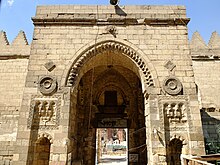| Revision as of 07:25, 15 December 2024 editAadirulez8 (talk | contribs)Extended confirmed users47,960 editsm v2.05 - Autofix / Fix errors for CW project (Link equal to linktext)Tag: WPCleaner← Previous edit | Revision as of 10:39, 15 December 2024 edit undoYusuf Asar Yathar (talk | contribs)Extended confirmed users1,751 editsmNo edit summaryTags: Visual edit Mobile edit Mobile web editNext edit → | ||
| Line 29: | Line 29: | ||
| Contemporary Muslim scholar, ] wrote a booklet, '']'' as a refutation of the book and a defence of Ibn Arabi in general.<ref name="Correct Islamic Doctrine">{{cite book|author=]|translator=]|title=Correct Islamic Doctrine/Islamic Doctrine|url=https://books.google.com/books?id=eFmKGFZTTcoC|publisher=]|publication-date=1999|isbn=9781930409019|pages=6–7}}</ref> | Contemporary Muslim scholar, ] wrote a booklet, '']'' as a refutation of the book and a defence of Ibn Arabi in general.<ref name="Correct Islamic Doctrine">{{cite book|author=]|translator=]|title=Correct Islamic Doctrine/Islamic Doctrine|url=https://books.google.com/books?id=eFmKGFZTTcoC|publisher=]|publication-date=1999|isbn=9781930409019|pages=6–7}}</ref> | ||
| === Quranic exegesis === | === Quranic exegesis === | ||
| In his tafsir (commentary of the Qur'an) titled ''Nazm al-Durar fi Tanasub al-Ayat wa-al-Suwar'', he drew extensively on the ] and the ] as sources to elucidate certain Qur'anic verses.<ref name=":0" /><ref name=":3">{{Cite book |last=al-Biqa'i |title=Nazm al-Durar fi Tanasub al-Ayat wa-al-Suwar |publisher=Dar Al Kutub Al Ilmiyah |isbn=9782745151339 |editor-last=Ghalib al-Mahdi |editor-first=A.R. |location=Beirut, Lebanon}}</ref> Aside from this, al-Biqa'i favoured the use of rhetorical and logical coherence as the primary tool for interpretation of the Qur'an.<ref name=":0" /><ref name=":3" /> | In his tafsir (commentary of the Qur'an) titled ''Nazm al-Durar fi Tanasub al-Ayat wa-al-Suwar'', he drew extensively on the ] and the ] as sources to elucidate certain Qur'anic verses.<ref name=":0" /><ref name=":3">{{Cite book |last=al-Biqa'i |title=Nazm al-Durar fi Tanasub al-Ayat wa-al-Suwar |publisher=Dar Al Kutub Al Ilmiyah |isbn=9782745151339 |editor-last=Ghalib al-Mahdi |editor-first=A.R. |location=Beirut, Lebanon}}</ref><ref name=":5">{{Cite book |last=al-Biqa'i |title=Tafsir Juzi' 'Aum |publisher=Dar Sader |year=2001 |isbn=9953130337 |language=Arabic |trans-title=Commentary on the Juzi'}}</ref> Aside from this, al-Biqa'i favoured the use of rhetorical and logical coherence as the primary tool for interpretation of the Qur'an.<ref name=":0" /><ref name=":3" /><ref name=":5" /> | ||
| == Works == | == Works == | ||
Revision as of 10:39, 15 December 2024
15th-century Muslim exegete| Burhān al-Dīn al-Biqāʿī | |
|---|---|
| Personal life | |
| Born | 809 AH, (1406 CE) Wasit Governorate, Iraq |
| Died | 885 AH, (1480 CE) Baghdad, Iraq |
| Main interest(s) | Tafsir |
| Religious life | |
| Religion | Islam |
| School | Shafi'i |
| Creed | Ash'ari |
| Muslim leader | |
| Influenced by | |
| Influenced | |
Burhān al-Dīn al-Biqāʿī (Arabic: برهان الدين البقاعي; died 1480) was a 15th-century Muslim scholar of the Shafi'i school of Islamic thought. He was an exegete as well as a prominent critic of the Andalusian philosopher, Ibn Arabi.
Life
Burhan al-Din al-Biqa'i, real name Ibrahim ibn Umar, was born in 1406 in the Beqaa as stated in his epithet al-Biqa'i (from Beqaa). He moved to Damascus and Cairo for his studies. In Cairo, he was a student of Ibn Hajar al-Asqalani. Through Ibn Hajar's recommendation, the ruling Burji Mamluk sultan, Sayf al-Din Jaqmaq accepted al-Biqa'i as a personal tutor. He was also promoted to a role as a teacher at the Mosque of al-Zahir Baybars in Cairo.

During his time in Cairo, he faced harsh criticism from contemporary scholars for his approach to Quranic exegesis. Some of the scholars ordered violent uprisings against him, so he quickly moved back to Damascus for his safety. One of the qadi (Islamic judges) of the Shari'a courts even ruled that al-Biqa'i was an apostate and heretic, but later retracted the ruling.
Burhan al-Din al-Biqa'i died in 1480 and was buried in the cemetery at Bab al-Saghir.
Views
Ibn Arabi
Burhan al-Din al-Biqa'i was very critical of Ibn Arabi and his ideas. He wrote a treatise titled Tanbih al-Ghabi ila Takfir Ibn 'Arabi (The Warning To An Ignorant Regarding Ibn Arabi's Apostasy). The book listed down several of Ibn Arabi's sayings which he considered as blasphemous. He also quoted evidences from other scholars contemporary to and before him, like Zain al-Din al-'Iraqi, to support his evidence that Ibn Arabi was a disbeliever.
Contemporary Muslim scholar, Jalal al-Din al-Suyuti wrote a booklet, Tanbih al-Ghabi bi-Tabri'at Ibn 'Arabi as a refutation of the book and a defence of Ibn Arabi in general.
Quranic exegesis
In his tafsir (commentary of the Qur'an) titled Nazm al-Durar fi Tanasub al-Ayat wa-al-Suwar, he drew extensively on the Hebrew Bible and the New Testament as sources to elucidate certain Qur'anic verses. Aside from this, al-Biqa'i favoured the use of rhetorical and logical coherence as the primary tool for interpretation of the Qur'an.
Works
- Nazm al-Durar fi Tanasub al-Ayat wa-al-Suwar: His commentary on the Qur'an, which displays Ash'arite influence.
- Tanbih al-Ghabi bi-Tabri'at Ibn 'Arabi: A criticism of Ibn Arabi and Ibn al-Farid. This work was heavily criticized by the polymath Jalal al-Din al-Suyuti, who wrote a refutation booklet titled Tanbih al-Ghabi bi-Tabri'at Ibn 'Arabi.
See also
References
- ^ Saleh, W. (2008a). In Defense of the Bible: A Critical Edition and an Introduction to al-Biqāʿī's Bible Treatise. Islamic History and Civilization. Brill. ISBN 978-90-474-3378-1.
- ^ "Burhān al-Dīn al-Biqāʿī: A Controversial Man – Mamlukisation of the Mamluk Sultanate II". Retrieved 2024-12-14.
- ^ "منهج العلامة البقاعي في كتاب «النُّكَت الوفيّة بما في شرح الألفية»". web.archive.org. 2011-01-20. Retrieved 2024-12-14.
- Roger Allen; D. S. Richards, eds. (2006). Arabic Literature in the Post-Classical Period. Cambridge University Press. p. 128. ISBN 9780521771603.
- ^ Antonella Ghersetti, ed. (2016). Al-Suyuti, a Polymath of the Mamluk Period. Islamic History and Civilization. Vol. 138. Brill. p. 11. ISBN 9789004334526.
- al-Biqa'i, ed. (2013). Tanbih al-Ghabi ila Takfir Ibn 'Arabi. Turath Publishing. ISBN 9957635212.
- Ibn Khafif (1999). Correct Islamic Doctrine/Islamic Doctrine. Translated by Gibril Fouad Haddad. Islamic Supreme Council of America. pp. 6–7. ISBN 9781930409019.
- ^ al-Biqa'i. Ghalib al-Mahdi, A.R. (ed.). Nazm al-Durar fi Tanasub al-Ayat wa-al-Suwar. Beirut, Lebanon: Dar Al Kutub Al Ilmiyah. ISBN 9782745151339.
- ^ al-Biqa'i (2001). Tafsir Juzi' 'Aum [Commentary on the Juzi'] (in Arabic). Dar Sader. ISBN 9953130337.